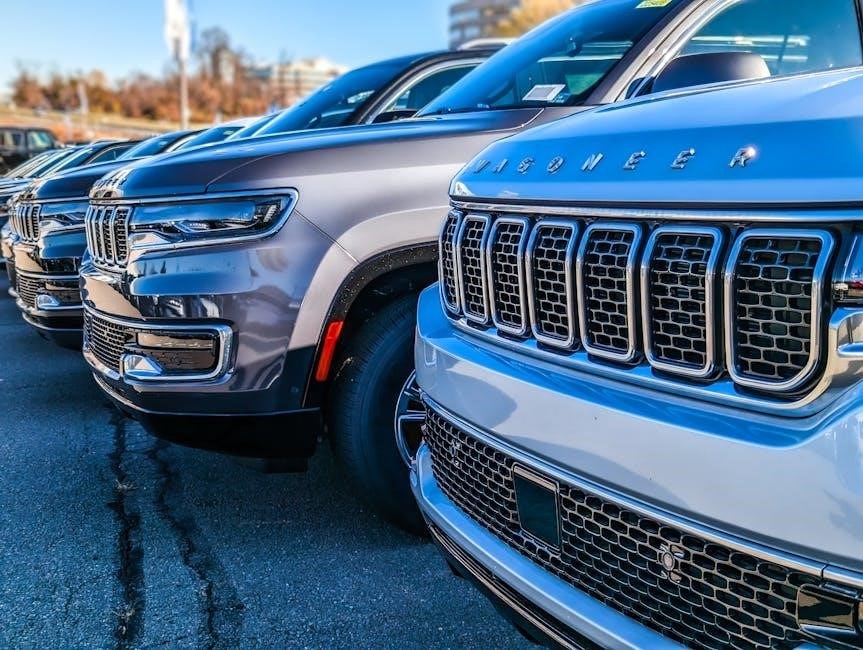A used car checklist is essential for ensuring confidence in your purchase. It helps verify the vehicle’s condition, history, and value, making the process safer and easier. Downloadable PDF checklists are available to guide you through inspections and negotiations.
Why a Checklist is Essential
A checklist is crucial for reducing risks and ensuring confidence when buying a used car. It helps identify potential issues, organizes the inspection process, and ensures no critical details are overlooked. With a checklist, buyers can make informed decisions and avoid costly surprises, making the purchase experience safer and more efficient.
Overview of the Checklist
A used car checklist is a comprehensive guide covering essential evaluations, from exterior and interior condition to engine performance and history. It includes pre-purchase research, test drive tips, and legal documentation. Available as a printable PDF, this tool ensures a systematic approach, helping buyers assess each vehicle thoroughly and make informed decisions confidently.
Essential Elements of the Used Car Checklist
The checklist covers exterior and interior condition, engine performance, tires, and vehicle history. It also includes sections for test drives and documentation, ensuring a thorough evaluation of the car.
Exterior Condition
Inspect the car’s bodywork for dents, rust, or mismatched panels. Check the windshield and windows for cracks. Ensure the paintwork is consistent and free from fading. Examine the wheels for curb damage and verify the tires have sufficient tread depth. Also, check for missing or damaged hubcaps and ensure all exterior lights are functional.
Interior Condition
Check for odors or signs of water damage. Inspect upholstery for stains, tears, or excessive wear. Ensure all electronics, including the radio, heating, and AC, function properly. Test all controls, such as seat adjustments and mirrors. Look for any missing or damaged interior components, like trim or dashboard pieces, and assess the overall cleanliness and condition.
Engine and Performance
Inspect the engine for leaks, such as oil or coolant. Check the dashboard warning lights and ensure they turn off after starting. Start the engine cold to detect unusual sounds or vibrations. Listen for knocking or grinding noises during operation. Verify the oil color and consistency, and ensure the coolant level is adequate. Test the acceleration and overall performance during the test drive.
Tires and Wheels
Check the tire tread depth and look for uneven wear, which may indicate alignment issues. Ensure all four tires, including the spare, match and are in good condition. Inspect the wheels for curb damage or missing hubcaps. Verify the wheel nuts are securely tightened and not stripped. Ensure the tires are properly inflated according to the manufacturer’s specifications before the test drive.
Vehicle History
Obtain a vehicle history report to check for accidents, prior damage, or major repairs. Ensure the VIN matches the car’s documentation. Review service records to verify maintenance and repairs. Look for any red flags such as flood damage or salvage titles. This step ensures transparency and helps avoid purchasing a problematic vehicle with hidden issues.

Researching the Car’s History
Obtain a vehicle history report and verify the VIN to check for accidents, damage, or major repairs. Review service records to ensure transparency and avoid hidden issues.
Vehicle History Reports
A vehicle history report provides crucial details about the car’s past, including accidents, major repairs, and flood damage. Always verify the VIN for accuracy and ensure the report is up-to-date. While not 100% foolproof, it offers valuable insights into the car’s condition and helps avoid purchasing a problematic vehicle.
Checking for Accidents or Damage
Inspect the car for signs of accidents or damage, such as cracks in the windshield, dents, or mismatched body panels. Check for water damage or rust inside the vehicle. Ensure the VIN on the registration matches the one on the car. Review the vehicle history report for any recorded accidents or major repairs.
Service Records
Review the service records to ensure regular maintenance was performed. Look for oil changes, part replacements, and tune-ups. Verify if any major repairs were done and if parts were replaced with genuine components. Inconsistent or missing records may indicate poor maintenance or hidden issues. This helps assess the car’s reliability and potential future costs.

Test Drive Checklist
A test drive is crucial to assess the car’s condition and performance. Check handling, acceleration, and brakes. Listen for unusual noises. Ensure all features work smoothly. Look for issues like clunking sounds or vibrations. Pay attention to comfort and visibility. A thorough drive helps confirm if the car is right for you.
Pre-Drive Checks
Before driving, inspect the exterior for damage, check tire pressure, and ensure all lights function. Review service records and ask the seller about the car’s history. Test all interior features, including AC, heating, and electronics. Look for warning lights on the dashboard. Ensure the vehicle is safe to drive and free from obvious issues. Use a printable PDF checklist to guide your pre-drive evaluation.

During the Drive
Check acceleration, braking, and transmission smoothness. Listen for unusual noises like clunking or grinding sounds. Test steering alignment and suspension by driving over bumps. Ensure the car accelerates evenly and brakes straight. Pay attention to warning lights on the dashboard. Note any vibrations or pulling to one side. This helps identify potential mechanical issues. Refer to your checklist for specific points to evaluate during the test drive.
Post-Drive Evaluation
After the test drive, inspect for leaks under the car and check the engine for overheating. Review the driving experience, noting any unusual noises or performance issues. Ensure all features work properly, such as heating, cooling, and electronics. Compare findings with your checklist to identify concerns. Decide if a second test drive or professional inspection is needed.

Documentation and Legal Requirements
Ensure the seller provides service records, vehicle registration, and warranty details. Verify the VIN matches all documents. Transfer ownership legally and confirm all paperwork is accurate and complete.
Vehicle Registration
Verify the vehicle’s registration is up to date and valid. Ensure the VIN matches the registration document. Check for any outstanding liens or loans. Confirm the seller’s name on the registration. Ensure all legal requirements are met before finalizing the purchase. This step ensures the car is legally transferred to your ownership without issues.

Review the vehicle’s service records to verify maintenance history. Check for oil changes, part replacements, and tune-ups. Ensure all services are documented and up to date. This helps confirm the car has been properly maintained. Any gaps in records could indicate neglect or hidden issues. Always request the original documentation from the seller.
Warranty and Insurance
Check if the vehicle still has a valid warranty and understand its coverage. Verify the expiration date and any transferability. Ensure the car is insured, and review insurance costs. Confirm if the seller offers any additional protection plans. This ensures financial protection and peace of mind after purchase.

Evaluating the Seller
Assess the seller’s credibility by asking consistent questions about ownership and condition. Ensure their story aligns with vehicle history and documentation; Trustworthiness is key to a reliable purchase.
Questions to Ask the Seller
Ask the seller about ownership duration, reasons for selling, and any existing issues. Inquire about service records, previous accidents, and recent repairs. Ensure their story aligns with the vehicle’s history. Consistency and transparency are key to assessing credibility and avoiding hidden problems. Verify all claims with documentation if possible.
Assessing the Seller’s Credibility
Evaluate the seller’s honesty by cross-checking their statements with documentation. Ensure they provide consistent answers about ownership history and vehicle condition. Look for transparency regarding past issues or repairs. Trustworthy sellers will gladly share service records and allow inspections. Be cautious of evasive or contradictory responses, as they may indicate hidden problems or dishonesty.
Budgeting and Financial Considerations
Set a realistic budget, including purchase price, insurance, and maintenance. Calculate additional costs like fuel, taxes, and potential repairs. Consider financing options to ensure affordability and transparency.
Setting a Budget
Determine your affordable price range by considering income, savings, and debt. Include long-term costs like insurance, fuel, and maintenance in your calculations. Use online tools to estimate expenses and ensure your budget aligns with your lifestyle needs.
Consider additional costs such as registration, taxes, and potential repairs. Factor in the cost of any desired extras, like extended warranties or accessories, to avoid financial surprises.
Calculating Additional Costs
Include insurance, fuel, maintenance, and registration in your budget. Check annual road tax costs and fuel consumption estimates. Review service records to anticipate repair needs. Consider potential future expenses like tire replacements or unexpected repairs to avoid financial surprises.
Negotiation and Finalizing the Purchase
Use your checklist to negotiate confidently. Start with a low offer and know when to walk away. Ensure all agreed repairs are documented before finalizing paperwork and payment.
Tips for Negotiation
Start with a low offer based on your research. Highlight any issues found during the inspection to justify your price. Stay polite but firm, and be ready to walk away if the deal doesn’t feel right; Ensure all agreed-upon repairs or discounts are included in the final agreement before signing. Always negotiate total price, not monthly payments.
Final Inspection and Paperwork
Conduct a final inspection to ensure all agreed-upon repairs are completed and no new issues exist. Review and verify the vehicle identification number (VIN) matches all documents. Ensure the seller provides clear ownership transfer paperwork, service records, and a signed title. Complete any necessary payments securely and obtain temporary registration if required before finalizing the purchase.

Common Mistakes to Avoid
Skipping the test drive, not checking service history, and ignoring red flags are common errors. These oversights can lead to costly repairs or mechanical surprises later.
Skipping the Test Drive
Skipping the test drive is a critical mistake. It hides potential issues like strange noises, performance problems, or transmission faults. A test drive is essential to assess the car’s condition and ensure it meets your needs. Avoiding it can lead to regret and financial loss down the road. Always test drive before finalizing a purchase.
Not Checking Service History
Overlooking the service history is a major mistake. It can hide essential information about maintenance, repairs, and potential issues. Without this data, you risk purchasing a car with unknown problems, leading to higher costs and reliability concerns. Always review service records to ensure the vehicle has been properly maintained.
Ignoring Red Flags
Ignoring red flags during a used car inspection is a critical mistake. Signs like mismatched paint, warning lights, or gaps in service history can indicate hidden issues. Overlooking these may lead to costly repairs down the road. Always address any red flags to ensure a reliable and problem-free purchase.

Additional Resources
Downloadable PDF checklists and expert guides are available online. Visit popularmechanics.com for a comprehensive used car inspection guide to ensure a smooth purchase process.
Printable Checklists
Downloadable PDF checklists are widely available online, offering a detailed framework for inspecting and evaluating used cars. These documents cover key areas such as exterior condition, engine performance, and vehicle history. Websites like Popular Mechanics provide comprehensive, printable guides to help buyers make informed decisions. Print and use them during inspections for a seamless process.
Expert Guides and Videos
Auto experts provide detailed guides and videos to help buyers navigate the used car market. Resources like Popular Mechanics offer comprehensive PDF checklists and tutorials. These tools highlight red flags, inspection tips, and negotiation strategies, ensuring buyers make informed decisions with confidence. Utilize these expert materials to streamline your purchasing process and avoid costly mistakes.
A used car checklist is invaluable for a successful purchase. It ensures confidence, helping buyers make informed decisions and avoid costly mistakes. Use this guide to secure your dream car wisely.
Final Thoughts

A used car checklist is a vital tool for ensuring confidence in your purchase. By following a detailed guide, such as a downloadable PDF checklist, you can verify the vehicle’s history, condition, and value. Stay vigilant, ask questions, and avoid costly mistakes. Remember, a thorough inspection and research can lead to a successful and stress-free purchase experience.
Next Steps
Download a used car checklist PDF and review it thoroughly. Research market values, check vehicle history, and inspect the car meticulously. Utilize expert guides and videos for additional insights. Ensure all documentation is in order and proceed with confidence. This structured approach will help you make an informed decision and secure a reliable purchase.

